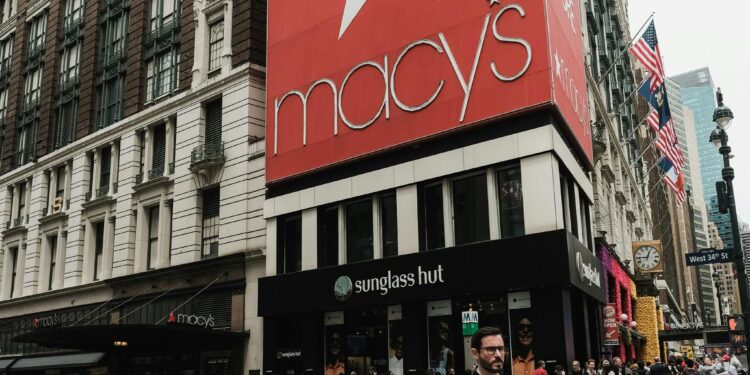Despite Positive Earnings, the Department Store Giant Struggles with Declining Sales and a Challenging Retail Environment
Macy’s (M), one of America’s most iconic department store chains, has delivered a mixed financial performance in its fiscal second quarter, reflecting the complexities of the current retail environment. While the company exceeded Wall Street’s earnings expectations, it also revised its full-year sales forecast downward, citing cautious consumer behavior and an increase in promotional activity. This move underscores the challenges Macy’s faces as it seeks to revitalize its business amid ongoing store closures and evolving consumer preferences.
A Mixed Quarter: Earnings Surpass Expectations, but Revenue Falls Short
Macy’s reported earnings per share of 53 cents, significantly above the 30 cents expected by analysts, according to a survey conducted by LSEG. However, the company’s revenue of $4.94 billion fell short of the anticipated $5.12 billion, highlighting the difficulties it faces in driving sales growth.
The earnings beat was not enough to offset concerns about the company’s revenue decline. Net sales dropped from $5.13 billion in the same period last year, and shares of Macy’s tumbled more than 9% in premarket trading following the announcement. This decline reflects investor apprehension about the company’s ability to navigate a challenging retail landscape.
Revised Sales Forecast and Consumer Behavior
Macy’s lowered its full-year net sales forecast to a range of $22.1 billion to $22.4 billion, down from the previously anticipated range of $22.3 billion to $22.9 billion. This revised outlook represents a year-over-year decline from the $23.09 billion in sales reported for fiscal 2023.
Comparable sales, which exclude the impact of store openings and closures, are now expected to decline between 2% and 0.5%. Previously, Macy’s had forecasted a range of a 1% decline to a 1.5% increase. This metric includes both owned and licensed sales, capturing the full spectrum of Macy’s merchandise, including items from third-party brands that pay for space within its stores and products sold through Macy’s online marketplace.
In a statement, Macy’s acknowledged the ongoing uncertainty in the discretionary consumer market, a reflection of the cautious spending patterns observed across its customer base. CEO Tony Spring elaborated on this in an interview with CNBC, noting that customers, including those shopping at Macy’s higher-end Bloomingdale’s stores, are more selective and conservative in their spending.
“There’s definitely a softness, a carefulness, a delay in the conversion of purchasing,” Spring said. He attributed this to a range of factors, including higher interest rates, inconsistent weather patterns, and a busy news cycle, all of which have contributed to a more cautious consumer mindset.
Strategic Shifts and Store Closures
In an effort to stabilize and grow its business, Macy’s has embarked on a significant restructuring plan, which includes closing about 150 of its namesake stores by early 2027. This represents nearly a third of its store base. The company is simultaneously investing in approximately 350 remaining locations and expanding its presence in suburban strip malls with smaller, more efficient store formats.
Macy’s is also capitalizing on its better-performing brands, particularly Bluemercury, a luxury beauty chain, and Bloomingdale’s. Bluemercury has been a standout, posting a 2% increase in comparable sales in the recent quarter, marking its 14th consecutive quarter of growth. In contrast, the namesake Macy’s brand saw a 3.6% decline in comparable sales, and Bloomingdale’s experienced a 1.4% drop.
The company’s turnaround strategy, which was unveiled earlier this year, focuses on revitalizing its top-performing stores. According to Spring, the first 50 stores to receive additional investment have shown positive results, with comparable sales up 1% on an owned-plus-licensed basis. These stores have outperformed other locations, particularly in categories like handbags, suggesting that targeted investments can drive incremental sales even in a tough market.
Challenges Ahead: Navigating a Shifting Retail Landscape
Despite some progress in its turnaround efforts, Macy’s still faces significant challenges. The broader retail environment remains volatile, with consumers being more discerning about their purchases, particularly for non-essential items. This cautious spending behavior, combined with increased promotional activity, is likely to continue exerting pressure on Macy’s margins.
Adding to the uncertainty is the recent attempt by an activist group to take Macy’s private. Although the company’s board decided to end negotiations with Arkhouse Management and Brigade Capital, the bid highlights ongoing concerns about the retailer’s future direction and potential vulnerabilities.
As of the close of trading on Tuesday, Macy’s stock had declined about 12% year-to-date, trailing behind the S&P 500’s approximately 17% gain over the same period. With its market cap standing at $4.9 billion, the company’s ability to execute its turnaround plan and regain investor confidence will be critical in the months ahead.
In the meantime, Macy’s continues to navigate the complexities of the modern retail landscape, balancing the need to drive sales growth with the realities of a more selective consumer base. The company’s efforts to streamline operations, invest in key locations, and leverage its strongest brands will be essential as it works to return to sustained profitability.
You might like this article:Target Surpasses Wall Street Expectations with Strong Q2 Performance











